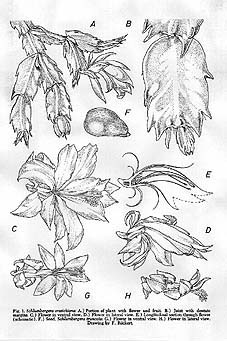Desc from CSJ(US)
p30/34 (1978)
Plant
- epiphytic, of a pendulous habit, with leaflike, flattened joints having
an elongated, terminal areole. The dentate joints are large 50 (45)
mm long and 32 (45)mm broad; ca each side are two or three strong teeth
with areoles in the angles; the margins are often reddish in color and
tend to be somewhat curled.
Flowers - zygomorphic, wide open, ca. 90mm long and 90mm broad.
There are about 20 petals up to 70mm long and 22mm broad, white at the
center and shading to the typical color of the genus, variously called
carmine-red or magenta (R.H.S. Colour Chart 71A) at the tips, giving
a generally pinkish
appearance. In contrast to other species of the genus, the petals are
not reflexed and so,
from the side, the stigrna and stamens cannot be seen.
Tepals - are fused at their base into a short "floral"
tube (= receptacle tube), only about l0mm long. At the base
of this tube the nectar chamber, characteristic of the genus, is developed
and is about 5mm long. About 140 stamens 55 (- 65)mm long with white
filaments and deep yellow anthers.
Style and stigma - are of a similar length, deep magenta in color
and the stigma clavate with 6(-8) lobes. The light green pericarpel
is about l2 mm long and five to six-angled.
Pollen - about 55m m in diameter; hexacolpate, colpi about 16m m
long. Exine with tectoral perforations of 0.5 to 1.1 m m diameter, surrounded
by an annulus. Tectum sculptured by about 2m m long and at their bases
2m m broad spinules.
Fruit - an obtuse, five- to six-angled, greenish-yellow to almost
white, succulent berry of about 20mm length and 16mm broad. It contains
in its dry inner cavity about 100 seeds.
Seeds - dark brown, flat, slightly curved, about 1.5mm long and
lmm broad. Testa surface consists of flat (tabular), isodiametric, mostly
hexagonal cells; along the dorsal side they are regularly arranged in
definite rows. The testa is slightly pitted by the sunken angles of
the cells. Surfaces of testa cells without cuticular folds or any other
surface sculpturing. The elongated hilum shows the same characteristics
as in other taxa of Rhipsalidinae and has a slimy-transparent, rilloid
appendix. The slightly curved embryo consists of a large hypocotyle
and somewhat succulent cotyledons; it fills up the whole seed volumen;
there appears to be no perisperm.
HABITAT Brazil, in the
Serra do Mar. Unfortunately, the exact place where the plants were
collected is not known but they were probably found near the small
town of Parati, about 9km from the coast at an altitude of about 1000
meters.
Notes from Bradleya 13
DISTRIBUTION Brazil (E
Sao Paulo & SW Rio de Janeiro); Serra da Bocaina and Serra do
Mar, epiphytic in Atlantic forest, at c. 1000 - 1300 m altitude.
Previous Page
|
|
